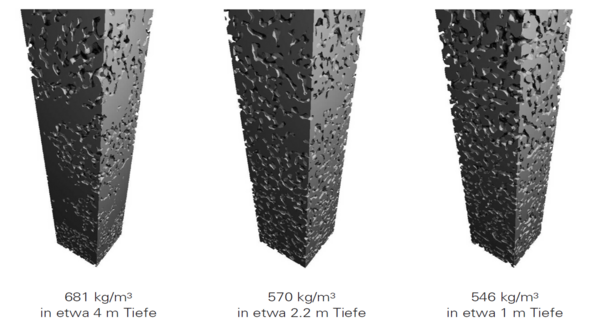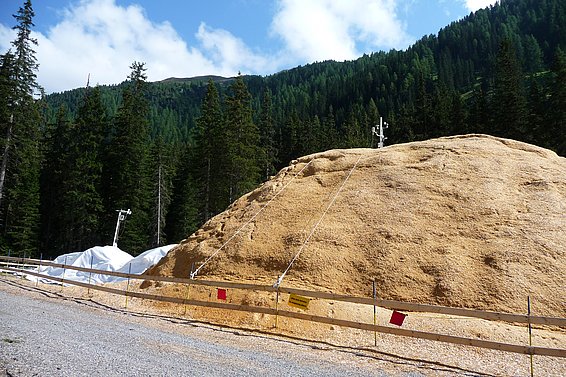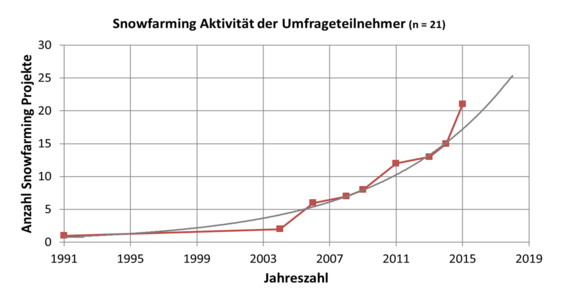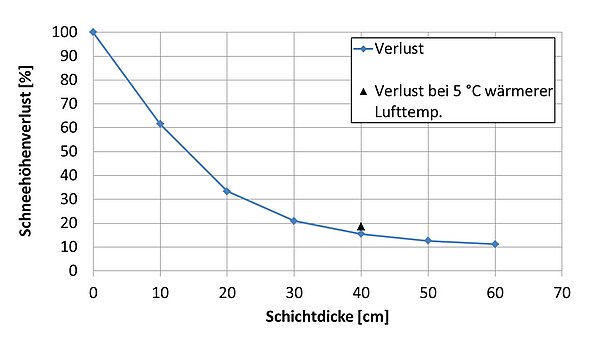
Snowfarming – preserving snow over the summer ¶
In recent years the value of snow as a scarce resource has become increasingly clear. A lack of snow in the winter has a major impact on tourist regions in the Alpine valleys and highlights the extent to which ski resorts at higher altitudes depend on the white stuff as well.
Winter sports resorts have been farming snow – storing it over the summer – to a growing extent in recent years. The practice entails producing piles of artificial snow, several metres high, in a suitable location towards the end of the winter and covering them with an insulating layer of sawdust, wood chips, or similar. This layer protects the snow underneath and prevents it from melting. Snow preserved in this way is used to prepare cross-country ski trails, as well as ski runs and jumps, at the start of the following winter. Snowfarming allows resorts to schedule an early start to the winter season largely independently of the weather, and to guarantee snow for a sporting event on a particular date.
Survey reveals growing interest in snow farming ¶
A survey by the SLF in the German-speaking Alps and Scandinavia reveals that interest in snow farming is on the rise. Ninety per cent of the 100 or so ski resort operators and local authorities surveyed were familiar with snow farming: around half (49%) viewed it positively, while 14% were critical.
Roughly half of the respondents who had not farmed snow so far were considering doing so, with 15% saying they definitely planned to start preserving snow over the summer. The main motivations were (a) to guarantee a minimum snow sport offering, (b) to ensure a punctual start to the season, and (c) to compensate for the shorter snowmaking periods in autumn and early winter.
For those with no plans to start snow farming, one reason given was the lack of suitable storage space. Many said that the amount of snow they could store would not be enough for the services they wanted to offer, while others expressed fears that the financial rewards would be small compared with the outlay required.
However, this was only borne out by about 30% of snow farming operators. Around half considered preserving snow over the summer to be a profitable activity, and two thirds said they would carry on snow farming. Just 5% said they would stop storing snow, whereas 27% were planning to store more.
Most respondents see scope for improvement ¶
The survey respondents reported snow volume losses over the summer of between 13 and 50%, the average being around 28%. Eighty per cent of respondents saw scope for improvement in snow farming. The biggest cost is usually distributing the snow in autumn, which is labour-intensive. At Snow Farming Davos, this accounted for around two thirds of the total costs in 2016 (excluding infrastructure). Snow farming projects were most commonly financed by mountain railway/cableway operators (47%) and local authorities (29%), while 12% of respondents received financial support in the form of subsidies.
Thickness of covering layer key to successful snow farming
In 2015, SLF researchers carried out detailed investigations of stored piles of snow in Davos. These found that only two thirds of the volume reduction was attributable to melting: the rest was caused by the snow settling due to its own substantial weight and the long storage period. This was demonstrated by snow density measurements as well as numerical simulations using the SNOWPACK snow-cover model.

The computer simulations also enabled a deeper understanding of how different weather factors affect the melting process and the way a sawdust layer works. Effective insulation was found to store heat during the day without transferring it to the snow, and then release as much of it as possible at night, mainly through long-wave outgoing radiation. Computer simulations with sawdust layers of different thicknesses showed that at least 30 to 40 cm of sawdust is needed to absorb most of the incoming heat during the day. SNOWPACK simulations also revealed that, with effective insulation, the losses are not particularly great, even at relatively high temperatures. For example, a 5 °C increase in air temperature only results in a snow depth loss of 3%.
The latest knowledge about snow farming is described in detail in the recently published Pistenpräparation und Pistenpflege (‘Ski-run preparation and maintenance’). As well as explaining the physical processes at work, this 20-page guide includes practical advice for planning and implementing a snow farming project together with detailed examples of snow storage piles in the Alps and Scandinavia.

15 years of snow farming practice and research in Davos
The first field trials on snow farming were carried out in 2008 in a joint project by the SLF with the local authority and tourist board in Davos to examine the feasibility of snow farming at lower altitudes and identify the most effective covering methods. This showed quite clearly that a thick layer of sawdust offered significantly better protection against melting than comparatively thin geotextiles. Under the cover of sawdust, barely a quarter of the snow melted. In the autumn, a 500-metre cross-country skiing trail was built from the remaining snow pile. Following this success in 2008, the local authority in Davos has continued and expanded its snow farming operations. Enough snow is now conserved over summer to build a four-kilometre trail in late October.

